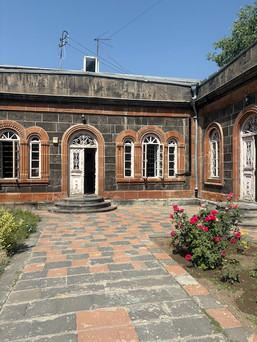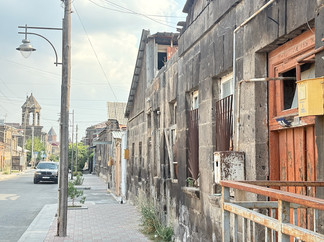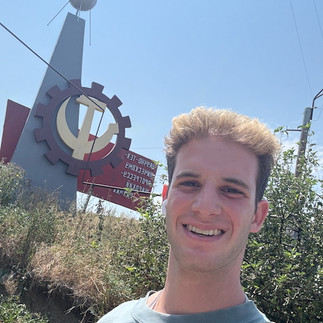Gyumri
- Ian Rosenberg

- Aug 2
- 4 min read
Gyumri is a really charming city, though it’s quite small and there’s not a ton to do. I stayed for two days in a nice guest house right by downtown. downtown is really nicely built up, with this stunning black and orange volcanic stone making up most buildings.
Whereas Yerevan is made from mostly pink and gray stones, Gyumri is positively a city of black and orange. The cathedral, houses and guesthouses (though not mine, unfortunately), stores, and restaurants are all made of this stone, leading to a wonderfully unique architectural identity. You simply cannot forget you’re in Gyumri.
Unlike Yerevan, whose center is filled with many-story buildings, Gyumri’s center is limited to two-, or maybe three-story buildings. Despite it being Armenia’s second largest city, it feels more like a Wild West town with the soul of a Rust Belt city. In places, it reminds me of Petoskey—with wide, gridded roads lined with short buildings, each with clothing stores or artisan shops. The restaurant scene is surprisingly fancy, with most restaurants feeling rather up-scale (though the prices are much cheaper than Yerevan even at the nicest restaurants). The same with the clothing stores—most stores sell designer clothes at a price point so high that I genuinely question whether they’re knock offs or not.
Despite this air of prosperity in this boutique city, there’s still hardship. In 1988, the city was hit by a magnitude 6.8 earthquake, killing between 25,000 and 50,000 of the city’s residents. Still today, walking around downtown, you’ll see no-longer-houses with rubble sticking out the once-windows or piling up in the defunct courtyards. Much of the city, especially its important sites, have been rebuilt. The cathedral and church are both magnificent nowadays, with the bright colors of the newly polished stone glimmering in the evening light, tainted by the monument to the victims of the earthquake and by the old pre-earthquake dome sitting on the ground nearby. The major streets of the city are now rebuilt, and fancy hotels and nice restaurants are abundant. There’s still plenty of life in the city—especially at night—and just like in Yerevan, it’s fun to wander around at night and hear all the musical performances on nearly every street.
I didn’t do too much in Gyumri, as there’s not that many attractions, but here’s some of the things I got up to in my 2.5 days there regardless. I visited the fort at the top of the city, which is now just a performance venue. It doesn’t have a lot of history—it was built in the 1800s—so I wasn’t too interested in it. But it was cool nonetheless and I got a good view of Gyumri.
After that, I checked out this hammer and sickle monument on the other side of town, and visited a museum dedicated to the “architecture and urban life of Gyumri.” That museum had information about the layout and urban planning of Alexandropol (Gyumri’s former name) which glorified the creative and bold decision to plan a city with a grid of streets. Then it moved into the arts of the city, which involve a rich heritage of metallurgy and ironworks, clothing, and stone carving. I’m glad I went to that museum, because it made me look at the city differently; I noticed, after my visit, the many custom-made downspouts and doorknobs and the carvings into the walls of buildings. It made me really appreciate just how detailed the artistry of the city is, despite none of the art being glaringly beautiful paintings or show-off-y sculptures. In Gyumri, the beauty lies in the mundane; everyday objects should be not just functional, but beautiful.
I ended up at… you guessed it… a folk dancing festival, put on by the same group that led the one in Yerevan. I had no idea any festival was happening in the first place, and I happened to be in the main square when I saw the band set up. Quickly, of course, I joined the circle and danced for a few hours, parading from location to location with the masses. I also encountered one that same night, so I got double the dancing in for my last full day in Armenia.
On Sunday, I ended up hopping around to the various masses going on throughout the city. It was funny because it was Tisha B’Av, so I was trying to have some time to think about my relationship with Judaism that day, but here I was at a Christian Mass. Anyways, I really enjoyed just standing there, admiring the music and the art that is the cathedral itself. In one church I went into, the priest was singing so terribly off key that I frankly could not stand it anymore. I left after only a minute or so. I ended up making the rounds to five churches, visiting two of them twice—the two most major ones in the center of the city. I also visited a museum dedicated to the famous Armenian poet Hovannes Shiraz, though no information in the museum was in English and there were no plaques about his life at all, just objects on display. Really only the hand-written letters would have revealed anything about his life, and at that point, Google Translate was certainly going to be no help.
I don’t have much to say about Gyumri. It was just really pleasant and pretty. I’d recommend spending a few days here to just enjoy the architecture and art if you’re ever in Armenia. From Gyumri, I took a marshrutka (wildly overpriced) to Tbilisi to continue my open book out in Georgia.

































Comments